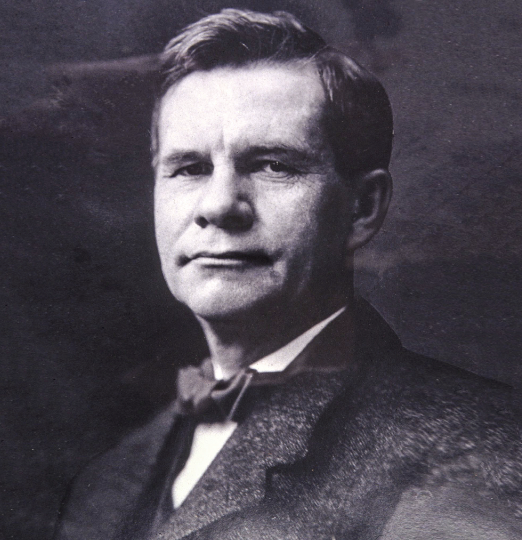
Photograph of Gustav Stickley
Photo courtesy of Craftsman Farms
Gustav Stickley (1858-1942) was an influential American furniture designer, and a leading figure in the American Arts and Crafts movement. The movement originated from British designers like William Morris and philosophers like John Ruskin in response to contemporary social movements like the Industrial Revolution, which produced interior decor of inferior quality for the masses. Additionally the Craftsman style, popularized by Gustav Stickley, emerged as a reaction against the ornate and heavily ornamented furniture of previous centuries. In contrast, the Arts and Crafts movement aimed to empower skilled craftsmen to design simple objects that restore soul and connection with nature to humanity.
Stickley played a key role in popularizing the Arts and Crafts style in the United States during the late 19th and early 20th centuries, contributing to the movement's international acclaim. Stickley believed that well-made, handcrafted items should be accessible to all social classes. His work often featured straight, clean lines, exposed joinery, and the use of quarter-sawn oak. The "Craftsman" or "Mission" style remains one of Stickley's most iconic contributions to furniture design. Characterized by its simplicity, functionality, solid construction, and the use of natural materials, this style became immensely popular and had a lasting impact on furniture design. For example, Mid Century Modern design drew inspiration from the American Arts and Crafts movement's quest for simple, authentic, and purposeful aesthetics.
In 1901, Gustav Stickley founded "The Craftsman," a magazine that became a significant platform for promoting the Arts and Crafts movement's aesthetic and philosophy in America. The featured print above demonstrates how Stickley used the magazine to share design ideas and advocate for handcrafted and naturalistic home design.
Early Craftsman pieces, made between the years 1901 to 1904, were considered the best of Stickley's work. As demand increased and economic factors came into play, there was a shift towards simplification and mass production.
By 1902, some designs were eliminated, and others were modified to facilitate easier mass production. This trend continued, and by 1905, the majority of designs were reconsidered to be more economically viable for the masses. The spindle line of furniture created by Peter Hansen in about 1905 was the last new line of furniture produced, its short lived production lasted only until about 1908 as it was also expensive to produce.
Competition in the furniture market became more intense by 1907, prompting Stickley's firm to focus on delivering high-quality products at lower prices. This necessitated a further simplification of designs. Elements like arches were eliminated, unnecessary cuts were reduced, and the wood used became thinner. Additionally, the finishing processes, such as fuming, were scaled back or eliminated to streamline production and reduce costs.
Gustav Stickley's career faced financial challenges, and he eventually lost control of his company in the early 20th century. Despite this setback, his legacy endures, and his influence on American design persists. Today, Gustav Stickley's furniture pieces are highly sought after by collectors and enthusiasts interested in the Arts and Crafts movement.
The timeless design of Craftsman furniture has made the movement continually relevant. Originally, the emphasis on quality handmade craftsmanship, use of natural materials, and functional considerations was a response to the Industrial Revolution. Today, such values are in line with current trends such as sustainability and minimalism.
